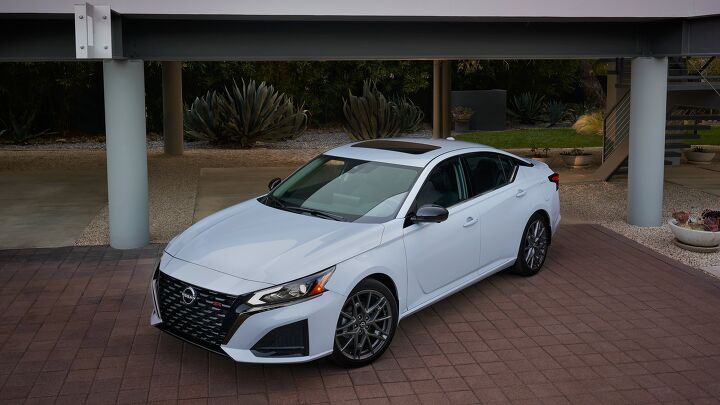Nissan Rental Sales: The Altima Might Remain the Fastest Car on the Road

If you’ve rented a car in recent years, there’s a great chance you were offered a Nissan of some sort. Whether it’s the Altima or Rogue, Nissan has long relied heavily on fleet sales, and the company’s most recent sales numbers show that the habit hasn’t died yet. A whopping 44 percent of its February 2024 sales, or around 40,000 vehicles, went to fleets, so get ready to be a temporary Nissan driver the next time you rent a car.
While surprising, the 44 percent number isn’t entirely out of line with Nissan’s sales through 2023, where around a quarter of its sales came from fleets during the first 11 months. That’s terrible news for its dealers, half of which are unprofitable, according to a source talking to Automotive News.
Though those numbers don’t look great for Nissan, its leader of U.S. sales, Judy Wheeler, said that the sales were due to a glut of Rogue crossovers and blamed consumers’ quicker-than-expected shift toward hybrids. The fleet sales help take some pressure off dealers to move a ton of excess inventory. The 2024 Rogue and Sentra were also delayed, so some of February’s sales should have taken place last year.
The company said it expects rental fleet sales to stabilize and noted that it would come within a point or two of its 15 percent target. Even so, it has already faced difficulties with fleet sales, as before the pandemic, it said the practice had damaged vehicle residual values and driven its dealers toward unprofitability.
Wherever the fleet sales number lands for 2024, it’s clear Nissan has work to do. A dealer told Automotive News that the brand is moving a fraction of the number of vehicles that rivals Toyota and Honda do, and it has the most days of inventory of any full-line automaker in January.
[Image: Nissan]
Become a TTAC insider. Get the latest news, features, TTAC takes, and everything else that gets to the truth about cars first by subscribing to our newsletter.

Chris grew up in, under, and around cars, but took the long way around to becoming an automotive writer. After a career in technology consulting and a trip through business school, Chris began writing about the automotive industry as a way to reconnect with his passion and get behind the wheel of a new car every week. He focuses on taking complex industry stories and making them digestible by any reader. Just don’t expect him to stay away from high-mileage Porsches.
More by Chris Teague
Latest Car Reviews
Read moreLatest Product Reviews
Read moreRecent Comments
- UnoGeeks Great information. Unogeeks is the top SAP ABAP Training Institute, which provides the best SAP ABAP Training
- ToolGuy This thing here is interesting.For example, I can select "Historical" and "EV stock" and "Cars" and "USA" and see how many BEVs and PHEVs were on U.S. roads from 2010 to 2023."EV stock share" is also interesting. Or perhaps you prefer "EV sales share".If you are in the U.S., whatever you do, do not select "World" in the 'Region' dropdown. It might blow your small insular mind. 😉
- ToolGuy This podcast was pretty interesting. I listened to it this morning, and now I am commenting. Listened to the podcast, now commenting on the podcast. See how this works? LOL.
- VoGhost If you want this to succeed, enlarge the battery and make the vehicle in Spartanburg so you buyers get the $7,500 discount.
- Jeff Look at the the 65 and 66 Pontiacs some of the most beautiful and well made Pontiacs. 66 Olds Toronado and 67 Cadillac Eldorado were beautiful as well. Mercury had some really nice looking cars during the 60s as well. The 69 thru 72 Grand Prix were nice along with the first generation of Monte Carlo 70 thru 72. Midsize GM cars were nice as well.The 69s were still good but the cheapening started in 68. Even the 70s GMs were good but fit and finish took a dive especially the interiors with more plastics and more shared interiors.


































Comments
Join the conversation
"The company said it expects rental fleet sales to stabilize and noted that it would come within a point or two of its 15 percent target. Even so, it has already faced difficulties with fleet sales, as before the pandemic, it said the practice had damaged vehicle residual values and driven its dealers toward unprofitability."
Before this 44 percent number, Nissan was running about 25 percent fleet sales, way above their 15 percent target level. Cars are sold to rental fleets at a discount (less revenue for Nissan). Also, rental companies sell cars after 6-8 months, or before 30,000 miles, resulting in a huge dump of used cars on the market, which depresses residual values for other Nissans - a double whammy.
Nissan reported making only $800 profit per new vehicle sold in 2023, the lowest of all the major automakers. As Peter De Lorenzo would say, a mile-long freight train of Not Good.
Big mistake. Daily rental fleet sales are the fastest path to brand devaluation and lower resale and residual values. Without any incentives, you can lease a superior Accord or Camry for less than an Altima simply because the residual value of the Nissan is so much lower than the Toyota or Honda. When these fleet cars come out of service and hit the auctions in big numbers, Altima values will drop even faster as there will be a huge glut on the market. This same thing happened after the 2008-2010 recession, automakers dumped excess production capacity into fleets and a year later you could buy a Chevy Malibu or Ford Taurus for 50% off MSRP with less than 20k miles. Nissan really needs to invest in improving their product to sell at retail and adjusting production to meet actual demand. Otherwise they'll be the next Mitsubishi.